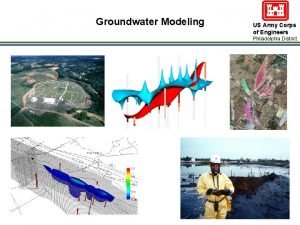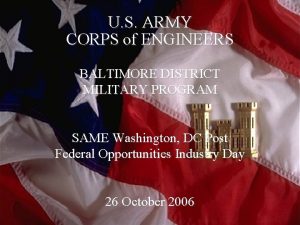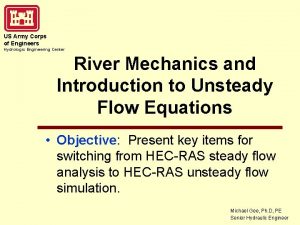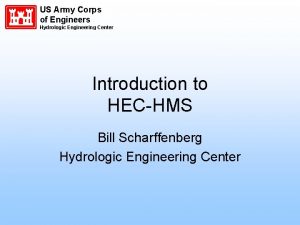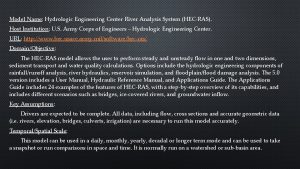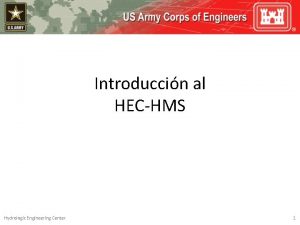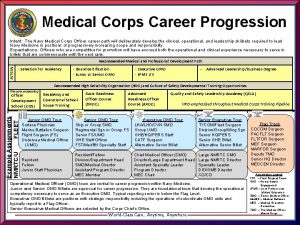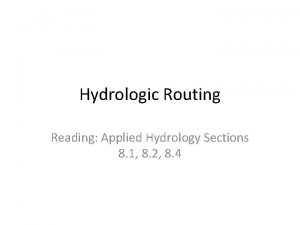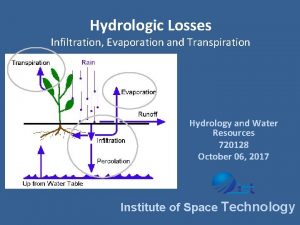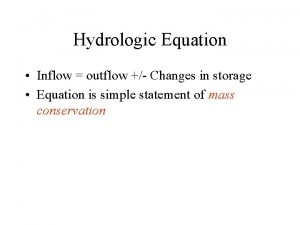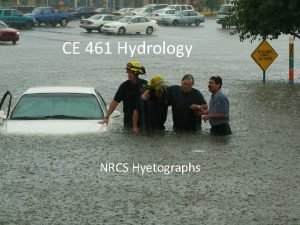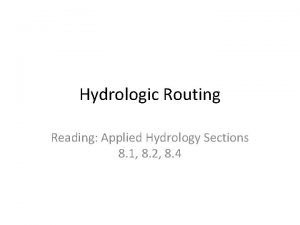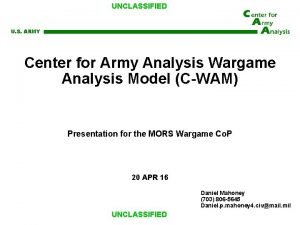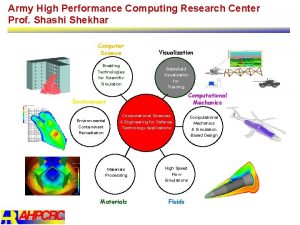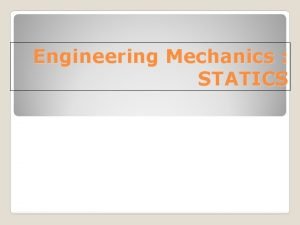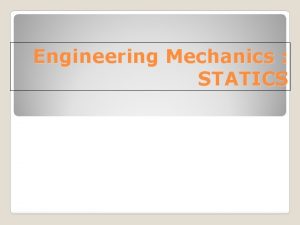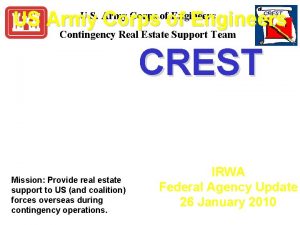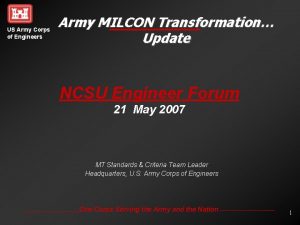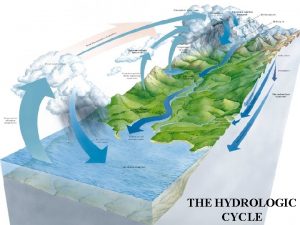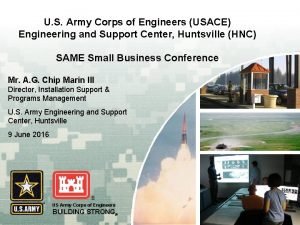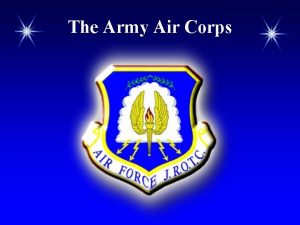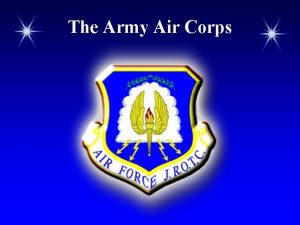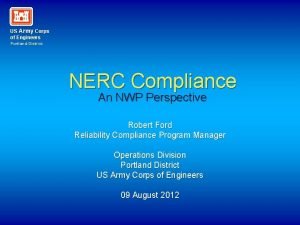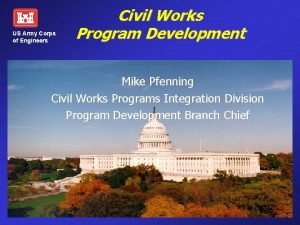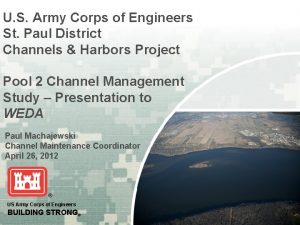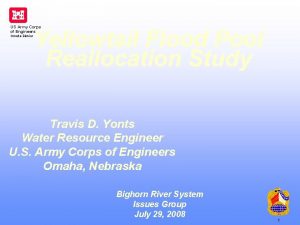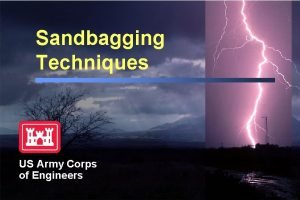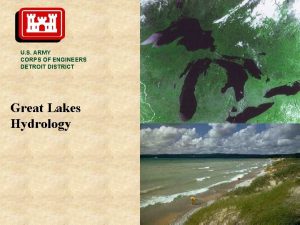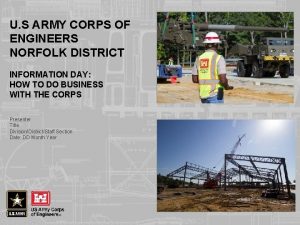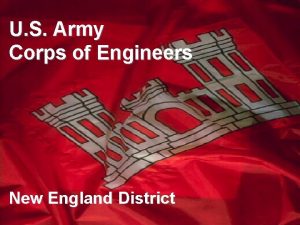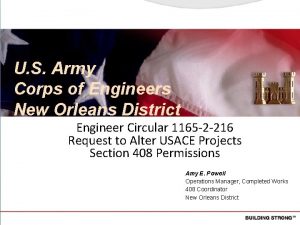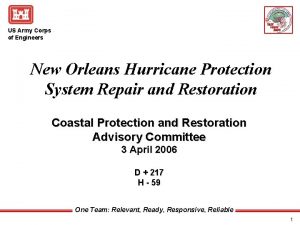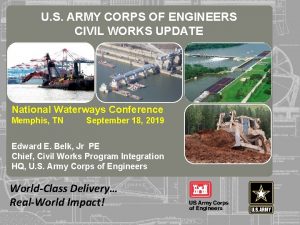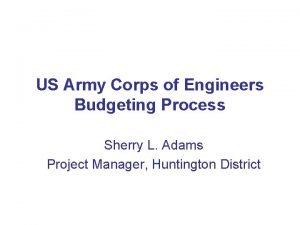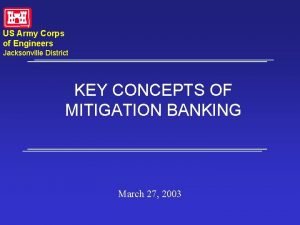US Army Corps of Engineers Hydrologic Engineering Center






























- Slides: 30

US Army Corps of Engineers Hydrologic Engineering Center Introduction to HEC-HMS Bill Scharffenberg Hydrologic Engineering Center

Objectives • Become familiar with the program and learn basic concepts of program organization, data components, and simulation runs. • Understand the different hydrologic elements and the methods available for each one. • See the different types of results visualization and statistical summaries. • Preview advanced capabilities.

Program Scope • Designed to simulate watershed hydrology. – Surface water modeling. – From meteorology to watershed outlet. • Tool kit of options. – Generalized modeling. – Mathematical model choices. – Analysis tools. • Graphical user interface – Map of the watershed. – Point-and-edit for entering and updating data. – Graph and table displays of simulation results.

Program Limitations • Deterministic models. • Uncoupled models. – Evapotranspiration-infiltration. – Infiltration-baseflow. • No aquifer interactions. • Constant parameter values. • Dendritic stream systems. – Flow splits possible but limited capability. • No downstream flow influence or reversal. – Backwater possible but only if contained within a reach.

Project • Container for main components. – Basin model. – Meteorologic model. – Control specifications. • Also holds additional components. – Time-series gages. – Paired data functions. – Grid data sets. • Provides analysis tools. – Parameter estimation using optimization theory. – Depth-area analysis for frequency storm. • Subdirectory name

Program Layout

Data Management • Configuration data and parameters. – Files within the project directory. – Automatically created, saved, loaded, etc. • Data Storage System HEC-DSS. – Time-series and paired data can be manually entered or retrieved from external files. – Grid data can only be retrieved from external files. – All time-series results computed during a simulation. • Automatic data handling. – Units conversion. – Interpolation or accumulation.

Main Components • Basin model gives the physical description of the watershed. – – – – Subbasin: watershed catchments where rain falls. Reach: rivers and streams. Reservoir: dams and lakes. Junction: confluence. Diversion: bifurcations and withdrawls. Source: springs and other model sinks. Sink: outlets and terminal lakes. • Meteorologic model describes atmospheric conditions over the watershed land surface. – Precipitation. – Potential evapotranspiration. – Snowmelt. • Control specifications: Time control during a simulation run.

Program Application • • • Create a new project. Enter time-series, paired data, and grid data. Create a basin model. Create a meteorologic model. Create control specifications. Create and compute a simulation run. View results. Create other alternatives, compute, and compare results. Save the project and exit.

Basin Map

Hydrologic Elements

Subbasin Infiltration • Loss rate methods: – – – – – Deficit constant. Exponential. Green Ampt. Gridded deficit constant. Gridded SCS. Gridded SMA. Initial constant. SCS curve number. Smith Parlange. Soil moisture accounting.

Subbasin Surface Runoff • Unit hydrograph methods: – – – Clark. SCS. S-graph. Snyder. User-specified. • Other methods: – Kinematic wave. – Mod. Clark distributed.

Subbasin Baseflow • Baseflow methods: – – – Bounded recession. Linear reservoir. Monthly constant. Nonlinear Boussinesq. Recession.

Reach • Routing methods: – – – Kinematic wave Lag Modified Puls Muskingum-Cunge Straddle stagger • Loss/gain methods: – Constant. – Percolation.

Reservoir • Routing methods: – Storage curve. – Outlet structures. – Specified release. • Possible structures: – – – Gated spillway (0 to 10). Overflow (0 to 10). Outlet (0 to 10). Pump (0 to 10). Dam break (0 or 1).

Precipitation • Historical methods: – – Gage weights. Inverse distance. User-specified. Gridded. • Hypothetical methods: – Frequency storm. – SCS storm. – Standard project storm.

Evapotranspiration • Available methods: – Gridded Priestley-Taylor. – Monthly average. – Priestley-Taylor.

Snowmelt • Temperature index method. – Subbasin band approach. – Gridded approach.

Simulation Run • Consists of one basin model, meteorologic model, and control specifications. – Precipitation or outflow ratio option. – Start states option. – Save states option. • View results for the current simulation run using menu or toolbar – Global summary table. • View results for one element in the current simulation run using the menu, toolbar, or basin map. – Graph, summary table, time-series table. • View custom graphs and time-series tables for elements in different simulation runs using the Watershed Explorer.

Global Summary Table

Element Graph

Element Summary Table

Element Time-Series Table

Continuous Simulation • "Event" simulation is only concerned with hydrology during and immediately after a storm. • "Continuous" simulation includes events and the time between them, up to several decades at a time. • Loss rate methods: – Deficit constant. – Soil moisture accounting. • May be needed to satisfy some study goals: – Reproduce frequency curve. – Water balance estimates. – Flow rates or volumes beyond instantaneous peaks.

Gridded Simulation • Precipitation, evapotranspiration, and snowmelt are defined on a grid cell basis. • Infiltration and excess precipitation is computed separately for each cell. • Mod. Clark transform method is used to process excess precipitation into runoff at the subbasin outlet. • Better definition of subbasin response: – Storm is small compared to the subbasin size. – Storm is very heterogeneous.

Advanced Reservoir Features • Interior flood protection projects. – Represents a pond on the "dry" side of a levee or floodwall where local drainage water accumulates. – Include culverts to pass water through the levee into the river when the river stage is low. – Include pumps to move water over the levee during floods. • Dam break evaluations. – Simulate the dam release from piping or overtopping failures.

Parameter Estimation • Automated tool for estimating parameters when observed flow is available. • "Objective function" measures how well the computed and observed flow hydrographs match. • "Search method" uses the objective function as input to an algorithm that determines how to adjust parameter values to find the optimum match. • Can provide good estimates for some parameters: – – Infiltration initial conditions and parameters. Unit hydrograph parameters. Baseflow initial conditions and parameters. Some routing parameters.

Depth-Area Analysis • Frequency storm is often used for estimating flows due to the 100 -yr storm or other return intervals. • Large watersheds often have many locations where flow estimates are required. • It can be tedious to develop storms with the correct area for each of the locations. • Analysis tool uses a simulation run and automatically adjusts the storm area for each selected location.

GIS Preprocessor • HEC-Geo. HMS can be used to create basin models using terrain data. • Start with a digital elevation model. • Select a watershed outlet and then Geo. HMS automatically delineates the watershed border and preliminary subbasins outlines. • Adjust subbasin outlets. • Geo. HMS creates a basin model that can be imported into HEC-HMS and also creates database table of parameters that can be estimated from terrain and other supplemental data layers.
 Army corps of engineers philadelphia
Army corps of engineers philadelphia Army corps of engineers baltimore
Army corps of engineers baltimore Hydrologic engineering center
Hydrologic engineering center Hydrologic engineering center
Hydrologic engineering center Hydrologic engineering center
Hydrologic engineering center Hydrologic engineering center
Hydrologic engineering center Army medical service corps officer career progression
Army medical service corps officer career progression Hec usace army mil
Hec usace army mil Vertical line in html
Vertical line in html Hydrologic routing
Hydrologic routing Infiltration
Infiltration Write the inflow as a formula
Write the inflow as a formula Hydrologic abstractions
Hydrologic abstractions Hydrologic continuity equation
Hydrologic continuity equation Objectiveable
Objectiveable Hydrology continuity equation
Hydrology continuity equation Water cycle the hydrologic cycle
Water cycle the hydrologic cycle Hydrograph
Hydrograph Us army chaplain center and school
Us army chaplain center and school Engineering ethics in practice a guide for engineers
Engineering ethics in practice a guide for engineers Royal academy of engineering ethics
Royal academy of engineering ethics Blue ridge job corps center
Blue ridge job corps center Oplan 4020
Oplan 4020 Army high performance computing research center
Army high performance computing research center System architecture example
System architecture example Forward engineering in software engineering
Forward engineering in software engineering Engineering elegant systems: theory of systems engineering
Engineering elegant systems: theory of systems engineering Elegant systems
Elegant systems Forward and reverse engineering
Forward and reverse engineering Statics centre
Statics centre Centroid statics of rigid bodies
Centroid statics of rigid bodies
